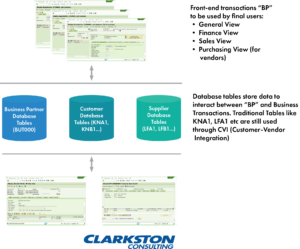Executing a Seamless S/4HANA® Business Partners (BP) Transformation
Do I Need To Do SAP Business Partners (BP) Transformation for SAP S/4HANA®?
The transformation of customer and vendor master data into SAP Business Partners is a critical part of an SAP S/4HANA migration project. It’s important that you check whether the version you are trying to migrate for SAP S/4HANA requires Customer/Vendor Integration.
Consider the following examples:
- Business Partners (BP) has been mandatory with S/4HANA Enterprise Management versions 1511 and 1610 as old transactions related to vendor and customers have become obsolete.
- The Business Partner Approach is not mandatory for the SAP Simple Finance 1503.
Therefore, you need to analyze first which version you’ll be implementing and plan accordingly. It’s a common mistake to think all SAP S/4HANA versions require Business Partners.
As a general rule, we can say that Customer/Vendor Integration (CVI) into Business Partners is mandatory for SAP S/4HANA but is NOT mandatory for SAP S/4HANA Finance.
In our latest SAP S/4HANA blog series, Business Partner (BP) Conversion in SAP S/4HANA, we laid out important learnings to keep in mind to ensure a successful Business Partners conversion in SAP S/4HANA.
Once You Have Determined You Need To Do Business Partners
Once you have confirmed that your SAP S/4HANA needs Business Partners, you then need to create a suitable plan.
If you’re migrating from a regular SAP R/3 system(s), you need to be aware that the traditional transactions used for maintenance of vendors and customers will not be directly used in SAP S/4HANA. Instead, these transactions will be redirected to transaction BP, which will act as the single point of entry to create, edit, and display master data for business partners, customers, and vendors.

sap business partner information
If you have a greenfield implementation, you need to create Business Partners from the beginning.
The good news is that the business transactions (such as creating a sales order, purchase order, etc.) will remain the same. They will continue accessing the traditional customer and vendor tables behind the scenes.
10 Steps To Transformation
- Conversion Checks
- Archive Customer and Vendor Data
Archive the customers and masters using the deletion flag, this will ensure a smooth conversion process. - Activate Business Functions
Activate the appropriate Business Functions for Customer/Vendor Integration that will enable the seamless integration of BP. - Check and Integrate Customer and Vendor Enhancements
If there are any code enhancements in place, you need to review their relevance for S/4HANA and take the proper action. - Perform Customizing Settings

sap business partner information
Verify customer and vendor account groups in relationship for Business Partner Roles, Number Ranges, etc.
- Checks Before Synchronization
Make sure the settings are correct during the data synchronization process. For every business partner you recreate, the customers and vendors database tables must be updated accordingly – as well as contact persons and organizational structure views (purchasing views, sales views, finance-company code views). - Convert the Data
Actual conversion of Customers and Vendors to BPs. There are several tools available to perform the technical data conversion. - Data Verification
Once the data has been converted to BPs, we must have a technical and business verification of the data and solve any issues. - Testing
If we are migrating from an SAP ERP system, it is recommended to do regression testing to make sure the business transactions are working properly. - Final Sign-Off
The last stage of the migration is a formal sign-off from the business that everything meets their expectations.
Key Considerations
Customers and vendors are critical to most business transactions in SAP for Order to Cash, Procure to Pay, and Finance. Therefore, a thorough data analysis is required to ensure a smooth transition to Business Partners. Some of the key considerations are:
- Business Views in Customer Master
Customer Master Views: General, Accounting, and Sales need to be analyzed and taken into account for the migration. Each one of these views play a key role in the order-to-cash process - Business Views in Vendor Master
Vendor Master Views: General, Accounting, and Purchasing need to be analyzed and taken into account for the migration. Each one of these views play a key role in the procurement process - Vendors as Customers and Vice Versa
This is not common functionality but can cause potential issues where a Customer or Vendor is setup in the other master for returns, refunds, etc., complicating migration - Contact Persons
Contact Persons must be correctly migrated to Business Partners - Partner Functions in Customers and Vendors
This is a key topic. Typically, customers and vendors use partner functions to assist in reporting, order processing, purchasing processing and others. The correct migration of these will ensure a smooth transition - Customer and Vendor Account Groups and their Relationship with Number Ranges
This is another very important topic. Customers and vendors usually have specific number ranges for sold-to customers, ship-to customers, raw material vendors, etc. You do not want to lose this logic in the migration. We can configure BPs to support this. - Tax Numbers
Be mindful during conversion of missing or incomplete customization of tax number categories, industries, and/or address forms. - Bank Information
Common master data quality issues include bank account number/control keys, missing account holders, and non-existing tax values.
Conclusion
The customer/vendor integration is a complex process that requires careful execution. Not performing this conversion comes at a high risk, as you’d be unable to do sales and/or purchase orders. As the conversion is so impactful to your business and operations, it’s critical that you have the right partner with experience executing this conversion efficiently. Contact us for more information and best practices on Business Partner conversion on SAP S/4HANA.
Co-author and contributions by Arturo Blasi.
I’m interested in learning more about Clarkston’s SAP Practice.
If you found this information interesting, subscribe to our blog to receive the latest SAP insights:
Subscribe to Clarkston's Insights
References:
Business Partner (BP) Conversion in SAP S/4HANA
SAP S/4HANA On-Premise
Conversion Guide for SAP S/4HANA



